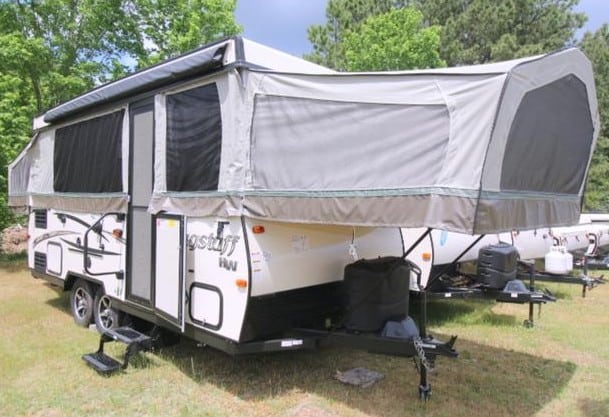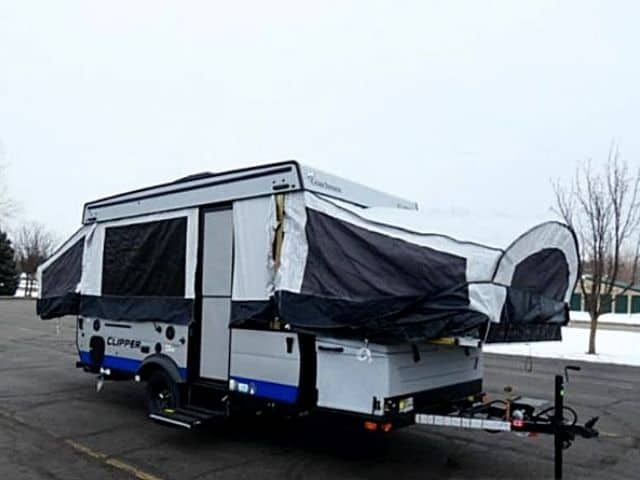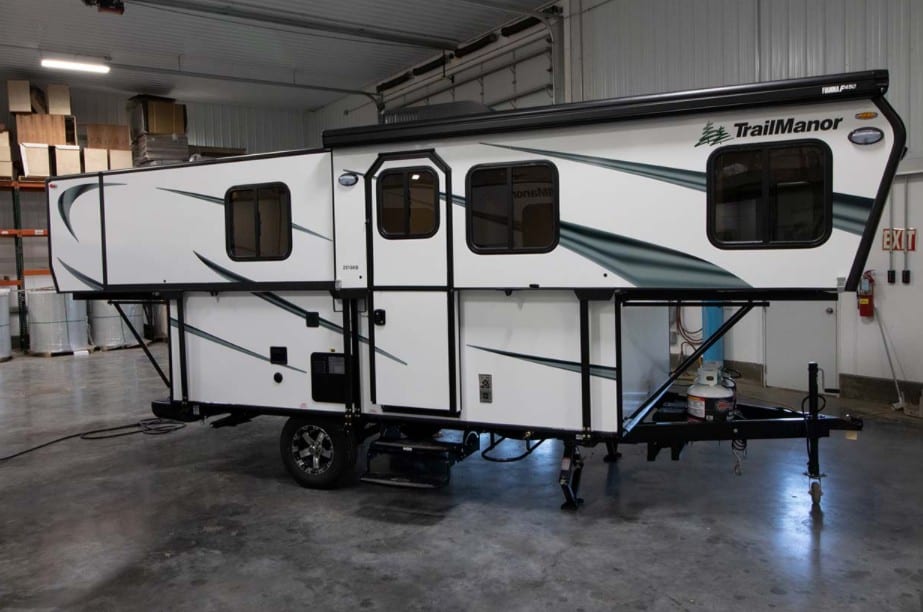Pop-up campers are one of the most popular types of RVs on the road today thanks to their lightweight design and affordable price.
But if you’re someone that likes to camp year-round, you’re probably wondering what the best pop-up campers are for winter camping.
So we scoured the pop-up camper market to find the 8 best pop-up campers for winter camping.
What to Know Before Using Any Pop-Up Camper in the Winter
While every pop-up camper on this list can be used in the winter, that doesn’t necessarily mean that they are full 4-season campers.
This is because none of these pop-ups have heated or insulated underbellies to keep the water lines or holding tanks from freezing.
Meaning that all pop-ups on this will need to be fully winterized before using them in cold weather.
In order to prevent the water lines from freezing and damage to the camper’s water system.
However, when you think about it, this really isn’t that big of a deal, because most pop-up campers don’t usually have that robust of water or plumbing system anyway.
As most usually only have a small kitchen sink and maybe an outdoor shower.
So the takeaway here is that if you plan to use the below or any pop-up campers in cold weather or during the winter, the pop-up camper will need to be fully winterized beforehand and all water storage will need to be kept inside the camper.
Best Pop-Up Campers for Winter
So how did we choose the best pop-up campers for winter?
And what makes one pop-up camper better than another for winter camping?
Below are the criteria we used in order to pick the best pop-up campers for winter.
- Built-in furnace capable of keeping the interior warm, even during freezing temperatures.
- Better insulating qualities and higher R-values to keep the warm air in and the cold air out.
- Additional cold-weather camping features such as dual propane tanks, alternative heating sources, and heated mattress pads.
- Higher ground clearances and available off-road packages to handle the snowy and muddy conditions often found during winter camping.
1. Coachmen Clipper Express 12.0TD XL
Quick Specs
- Price: $15,000
- Dry Weight: 2,147 Pounds
- Length: 16 Feet 8 Inches
- Sleeping Capacity: 3
- Winter Features: 20,000 BTU Furnace, Fiberglass Exterior Walls, Thetford Porta Potti, Optional 15″ Off-Road Tires and Lifted Axle
The Coachmen Clipper Express 12.0TD XL makes a great little pop-up camper for couples or small families looking to do some winter camping, thanks to its built-in 20,000 BTU furnace and unique single pivot point, which helps to reduce the amount of tent fabric used on this pop-up.
As over 80% of the exterior walls on this pop-up camper are hard-sided fiberglass walls, as opposed to tent fabric.
Which helps to keep the interior of this pop-up camper nice and warm even on the coldest of nights.
Another nice feature that the Clipper Express 12.0TD XL is equipped with is the Thetford Porta Potti, which is great for cold weather camping because the small toilet is completely self-contained inside the heated space of the camper.
This means you can actually use this porta-potty even when the temperature outside is below freezing, just make sure you empty and winterize the porta-potty before you turn the heat off inside the camper.
For more information on the Coachmen Clipper Express 12.0TD XL, make sure you check out Coachmen’s website by clicking here.
2. Aliner Expedition
Quick Specs
- Price: $25,000
- Dry Weight: 1,850Pounds
- Length: 18 Feet
- Sleeping Capacity: 4
- Winter Features: Hard-Sided Fiberglass Exterior Walls, Furnace, Dual Propane Tanks, Available Extreme Off-Road Package
The Aliner Expedition is one of our favorite pop-up campers for winter, thanks to its hard-sided A-frame design, which completely eliminates the tent fabric found on most pop-ups.
As this fully enclosed hard-sided pop-up camper provides excellent insulation and R-value to help keep the inside of this pop-up camper nice and warm with assistance from the built-in furnace.
This hard-sided pop-up camper from Aliner also features dual propane tanks to help make sure you never run out of propane while winter camping and has an available extreme off-road package, which helps to ensure this pop-up can handle just about anything that mother nature can throw at it.
For more information on the Aliner Expedition, be sure you check out Aliner’s website by clicking here.
3. Forest River Rockwood A213HW
Quick Specs
- Price: $16,000
- Dry Weight: 2,670Pounds
- Length: 21 Feet 2 Inches
- Sleeping Capacity: 4
- Winter Features: Hard-Sided Fiberglass Exterior Walls, 10,000 BTU Cool Cat Heat Pump, Heated Mattress
Another pop-up camper that also uses the hard-sided A-frame design is the Forest River Rockwood A213HW, which has far better insulating qualities compared to the more standard tent-style pop-up camper.
But Forest River didn’t stop there with their winter camping features, as this well-appointed pop-up camper also features a 10,000 BTU Cool Cat Heat Pump that will provide heat in the winter and cool air in the summer.
As well as a heated mattress to keep you nice and warm while sleeping, even when the temperature drops outside.
And the great thing is that Forest River Rockwood A213HW does all this for about $10,000 less compared to the more expensive Aliner Expedition from above.
One thing to keep in mind though about this particular pop-up camper from Forest River is that because the heat inside the camper comes from an AC with a heat pump instead of a dedicated furnace, you will have to rely on RV hookups at a campsite to power the AC.
For more information on the Forest River Rockwood A213HW, check out Forest River’s website by clicking here.
4. Forest River Flagstaff High Wall HW29SC

Quick Specs
- Price: $25,000
- Dry Weight: 3,721Pounds
- Open Length: 27 Feet 9 Inches
- Sleeping Capacity: 4
- Winter Features: 20,000 BTU Furnace, Dual 20-Pound Propane Tanks, Heated Mattress
One of the largest pop-up campers on this list is the Forest River Flagstaff High Wall HW29SC, which has an open exterior length of 27 feet 9 inches as well as a slide-out for exterior interior and floor space.
This premium pop-up was built and designed to be the ultimate in pop-up campers, as it comes with just about everything you could want and then some.
Including such features as a wet bath with a combined shower and cassette toilet, a large u-shaped dinette on a slide-out, a full kitchenette with sink, a three-burner propane stove, microwave, and a three-way fridge, and a power roof lift.
And can even be optioned with a 13,500 BTU roof AC or 15,000 low-profile roof AC, which is a real rarity for a pop-up camper.
And when it comes to winter camping features as you would expect, this high-end pop-up camper has it all including a robust 20,000 BTU furnace, dual 20-pound propane tanks, and even heated mattresses.
For more information on the Forest River Flagstaff High Wall HW29SC, check out Forest River’s website by clicking here.
5. Coachmen Clipper 1285SST Classic

Quick Specs
- Price: $23,000
- Dry Weight: 2,840Pounds
- Open Length: 23 Feet 5 Inches
- Sleeping Capacity: 4
- Winter Features: 20,000 BTU Furnace, Laminated Insulated Bed Platforms, Optional Thetford Porta Potti
Another large and spacious pop-up camper that has numerous cold-weather and winter camping features is the Coachmen Clipper 1285SST Classic.
Which features a robust 20,000 BTU furnace, which helps to keep the pop-up camper warm despite its thin tent-style walls and laminated insulated bed platforms to keep you insulated from the cold air while sleeping.
In addition, like the Coachmen Viking 12.0TD XL, this Coachmen Clipper can be optioned with a Thetford Porta Potti that you can use even in the winter, thanks to the fact that the porta potty is completely self-contained inside the camper.
Again just make sure you empty and winterize the porta-potty before you turn the heater off inside the camper to avoid damage to the porta-potty.
For more information on the Coachmen Clipper 1285SST Classic, be sure to check out Coachmen’s website by clicking here.
6. Forest River Rockwood Limited Series 1940LTD
Quick Specs
- Price: $12,000
- Dry Weight: 1,608Pounds
- Open Length: 20 Feet 2 Inches
- Sleeping Capacity: 4
- Winter Features: 20,000 BTU Furnace, Heated Mattresses, Optional Dual 20-pound Propane Tanks
While this tent-style pop-up camper might not have as much insulating capability compared to the hard-sided pop-up campers from above, this pop-up is still more than capable of winter camping once it’s been winterized.
Thanks to its heavy-duty 20,000 BTU furnace and optional dual 20-pound propane tanks, which allows you to keep the inside of the pop-up nice and toasty regardless of how low the temperature drops outside.
In addition, this affordable pop-up camper also has heated mattresses in both sleeping berths, so you don’t have to climb into a cold bed when it’s time to get some shut-eye.
For more information on the Forest River Rockwood Limited Series 1940LTD, check out Forest River’s website by clicking here.
7. Aliner Ranger 10
Quick Specs
- Price: $18,000
- Dry Weight: 1,225Pounds
- Open Length: 12 Feet 8 Inches
- Sleeping Capacity: Up to 3 (Depending on Floorplan)
- Winter Features: Furance, Hard-Sided Exterior Fiberglass Walls, Glass Windows, Dual Propane Tanks, Optional Command AC Heat Pump
Another great hard-sided pop-up camper option that’s great for winter is the Aliner Ranger 10, which offers excellent insulation and R-values as well as a built-in furnace to keep you warm.
But the cold-weather features on this more affordable Aliner don’t end there, as the little lightweight pop-up camper also features dual propane tanks to help ensure you don’t run out of propane on those cold winter nights.
As well as an optional Command AC with a heat pump that would allow you to save your propane by not using the furnace if you happen to be at a campsite with electricity that can run the AC heat pump.
For more information on the Aliner Range 10, be sure to check out Aliner’s website by clicking here.
8. Trailmanor 2518KB

Quick Specs
- Price: $36,000
- Dry Weight: 2,600Pounds
- Open Length: 25 Feet
- Sleeping Capacity: 4
- Winter Features: Suburban 20,000 BTU Furnace, Full Hard-Sided Fiber Glass Walls, Dual 20-pound Propane Bottles with Automatic Changeover, 3-Inch Laminated Floor with Metal Underbelly
When you looking for the ultimate in luxury and comfort in a winter pop-up camper, you need to look no further than this pop-up camper from Trailmanor.
As this clever camper provides the benefits of both a standard hard-sided travel trailer and a pop-up camper all rolled into one convenient package.
Thanks to its ingenious design that allows the top of the pop-up camper to raise up providing a full-height hard-sided pop-up camper while in camp mode.
But also allows the top of the camper to lower down when in travel mode, providing a very low-profile trailer while towing.
In addition, this hard-sided pop-up camper features a Suburban 20,000 BTU furnace for those extra cold nights and dual 20-pound propane tanks with automatic changeover ensuring the propane furnace will keep running all night long.
For more information on the Trailmanor 2518KB, make sure you check out Trailmanor’s website by clicking here.
Can a Pop Up Camper be Used in the Winter?
Pop-up campers are one of the most affordable and lightweight campers that you can buy but due to its often minimalist design and affordable price, people often wonder if you can use a pop-up camper in the winter.
The good news is, is that yes you can absolutely use a pop-up camper in the winter as long as you have a good heat source and fully winterize the pop-up camper beforehand.
How to Use a Pop Up Camper in the Winter
Now that you know you can use a pop-up camper in the winter, let’s go into a little more detail about exactly how to use a pop-up camper in the winter.
Make Sure You Have a Robust Heat Source
The most critical item you need if you plan to use a pop-up camper during the winter is a good source of heat.
As a pop-up camper is typically not very well insulated due to its tent-style construction and thin lightweight half-walls.
So the heat source needs to be robust enough to combat the extensive heat loss experienced on a pop-up camper.
For this, I would recommend choosing a pop-up camper that has a built-in furnace with a heat output of at least 10,000 BTUs.
But to really ensure you stay warm inside a pop-up camper during those cold winter nights, you ideally want to choose a pop-up camper that has a 20,000 BTU furnace.
Fully Winterize the Pop Up Camper Beforehand
Pop-up campers are not designed or meant to be 4-season campers.
This means that if you plan to use your pop-up camper in the winter, you will need to fully winterize your camper in order to avoid and prevent damage to your camper’s water system.
But that doesn’t mean you have to camp without water, it just means that any water you plan to use and store needs to be inside the heated camper.
For this, I would recommend getting a couple of 6-gallon rigid water containers like the Reliance Products Desert Patrol 6 Gallon Water Container on Amazon, which you can see by clicking here.
Have More Than One Way to Stay Warm
While a good main heat source is critical if you plan to do a lot of cold-weather camping with your pop-up.
It’s also a good idea to not rely solely on your main heat source to keep warm, while winter camping with a pop-up.
So here are some other ways to help ensure you stay nice and warm inside your pop-up camper even when the temperature outside starts to drop.
- Layering – While layering is a fairly obvious one, it’s still worth mentioning, as you definitely want to make sure you wear multiple layers of clothing inside the pop-up to help stay warm.
- Heated Blankets – When your sleeping in a pop-up camper in the winter, a heated blanket can make all the difference in the world.
- Footwear – You can count on the floor of the pop-up camper to be cold, no matter how warm you keep the camper. So it’s a good idea to either wear two pairs of socks or have a pair of crocs or slip-on sandals to walk around with inside.
- Space Heaters – Another way you can add some supplemental heat to the inside of a pop-up camper is to use a space heater. However, if you choose to go this route, it’s important you exercise extreme caution and never leave a space heater unattended or go to sleep while a space heater is running.
- Bunk End Covers – One of the greatest sources of heat loss in a pop-up is the ceilings of the bunk ends on either side. So to address this issue, consider adding bunk end covers to the top of the bunk ends. For more information on bunk end covers, check out Pop Up Gizmos website, which is one of the leading manufacturers of bunk end covers.
Can You Live in a Pop Up Camper Year-Round?
There are definitely RVs that are better suited for year-round living than a pop-up camper, however, you can live in a pop-up camper year-round, if you have a plan and are willing to sacrifice some on comfort.
To see how one family lives year-round in their pop-up camper, check out the above YouTube video.
Do Pop Up Campers Have Heat?
While many pop-up campers do have heat, some basic and more affordable pop-up campers do not have a built-in heat source.
For those pop-up campers that do have heat, this is generally provided either through a built-in furnace or an air conditioner with a heat strip.
But if you’re planning on doing any amount of cold-weather camping, you want to make sure the pop-up camper has a built-in furnace as opposed to just an AC with a heat strip.
As an air conditioner with a heat strip is not powerful enough to properly heat a pop-up camper during winter conditions.
Also, the furnace has the added benefit of not relying on electricity from a campsite to run, as the furnace uses propane as its heat source.
However, if the furnace is a forced-air system, you will need to make sure the batteries on the pop-up are capable of running the blower motor on the furnace.
Are Pop Up Campers Insulated?
Pop-up campers are some of the least insulated RVs on the market today mainly due to their design.
Because while every other RV and travel trailer is built with insulated fiberglass or aluminum exterior walls, the standard tent-style pop-camper has walls made from canvas or some other thin synthetic material like you might find on a tent.
But that doesn’t mean that pop-up campers have no insulation.
As even a tent-style pop-up camper will typically have a small amount of insulation, thanks to its heavy canvas walls and multiple layers of material throughout the pop-up.
If you’re looking for the ultimate insulated pop-up camper though, you need to go with a hard-sided A-frame pop-up camper, such as the Aliner Expedition or the Forest River Rockwood A213HW.
As these types of pop-up campers have fiberglass insulated walls and real windows like you might find on a more traditional travel trailer.
To see the best 5th wheels for winter camping, check out our article “10 Best 5th Wheels for Cold Weather Camping“.
Recent Posts
When cruising down the highway in your RV, the last thing you want is a tire blowout! Not only is it dangerous, but RV tire replacement isn't cheap, costing $200 to $300 per tire. The good news,...
Nothing ruins an RV adventure faster than a breakdown with no way to fix it. Because of this, every RVer should have a well-stocked RV tool kit for those unexpected roadside emergencies and campsite...

